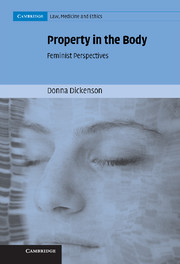Book contents
- Frontmatter
- Contents
- Acknowledgements
- Preface
- 1 Do We All Have ‘Feminised’ Bodies Now?
- 2 Property, Objectification and Commodification
- 3 The Lady Vanishes: What's Missing from the Stem Cell Debate
- 4 Umbilical Cord Blood Banks: Seizing Surplus Value
- 5 The Gender Politics of Genetic Patenting
- 6 Biobanks: Consent, Commercialisation and Charitable Trusts
- 7 The New French Resistance: Commodification Rejected?
- 8 Tonga, the Genetic Commons and No Man's Land
- 9 Afterword
- Bibliography
- Index
4 - Umbilical Cord Blood Banks: Seizing Surplus Value
Published online by Cambridge University Press: 15 December 2009
- Frontmatter
- Contents
- Acknowledgements
- Preface
- 1 Do We All Have ‘Feminised’ Bodies Now?
- 2 Property, Objectification and Commodification
- 3 The Lady Vanishes: What's Missing from the Stem Cell Debate
- 4 Umbilical Cord Blood Banks: Seizing Surplus Value
- 5 The Gender Politics of Genetic Patenting
- 6 Biobanks: Consent, Commercialisation and Charitable Trusts
- 7 The New French Resistance: Commodification Rejected?
- 8 Tonga, the Genetic Commons and No Man's Land
- 9 Afterword
- Bibliography
- Index
Summary
Christmas shopping for the unborn baby has never been easy. However, stem cell technology may have brought what is possibly this year's most original gift. For a mere £1,250, it is possible to harvest stem cells from the umbilical cord at birth and store them frozen for up to 25 years. ‘Stem cells are not just for life – they're for Christmas’, said Shamshad Ahmed, managing director of Smart Cells International, a company offering stem cell gift certificates as a new line this year. He has sold the idea to fifty customers so far – mainly grandparents who want their descendants to have access to stem cells' healing powers in the event of illness or injury.
Private umbilical cord blood banks like Smart Cells International offer benevolent grandparents and parents a ‘most original gift’, tinged with the glamour of the stem cell technologies. Umbilical cord blood banking plays on parents' natural wish to do everything possible for their child, even if the ‘healing powers’ of stem cells are so far largely theoretical. If there is a possible enormous benefit to be gained, and no risk of harm, then a Pascal's Wager strategy would still dictate in favour of cord blood banking, however speculative and distant that benefit might be. Just as Pascal counselled doubters to wager on the existence of God because the benefit to be gained is eternal bliss, no matter how shaky the grounds for belief might appear, so parents might regard banking cord blood as a good investment because the potential return is of such enormous value, however inchoate the stem cell technologies' promises of cure might be at present.
- Type
- Chapter
- Information
- Property in the BodyFeminist Perspectives, pp. 83 - 107Publisher: Cambridge University PressPrint publication year: 2007

